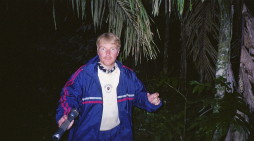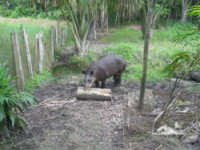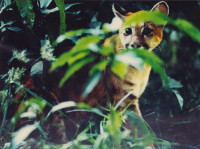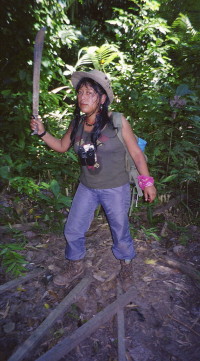
Maybe it was no puma at all. Later we understood that the colour of
felines eyes in the night reflects like yellow-white-sky blue colour. It's the
same for puma like any other cat.
The red eyes our guide Ruby
noticed
in that night was probably not a puma, but more likely the eyes
of a tapir. It could also be a peccary. But anyway
it was scary situation.
A tapir is a large Amazonian animal, related to rhinos, with pig-like heads,
long fleshy noses and rounded ears.
| Photo. A peccary is eating lunch in Amazon.
© Josh Cutler. |
 |
We also heard from others that tapirs and peccaries used
to sleep in the area where we camped. They don't make any sound, just a
whistling call, and it's only possible see the reflecting red eyes and not the
rest of the body with the flashlight (because they are dark brown in colour).
|
Photo. Puma searching for food.
© Expediciones VILCA.
I wouldn`t like to be the prey.
But was it something else that we spottet in the dark, for example a
tapir? |
 |
Tapirs can hardly make
sound when they get closer (approach) to clay licks (at
the beginning). They are known to be very carefully. We can hear when they
walk in the mud in the clay lick and when they run is similar to the
horses (their relatives too).
|
Tapirs are mostly nocturnal, partly diurnal; terrestrial; solitary, but
several use the same area. Eyes shine bright pale yellow.
When we used red light to observe that probably was a tapir that night
in the clay lick, we saw red eyes.
Photo. Ruby Huanca, our brave guide.
She works as an independent guide (freelance).
Ruby can be contacted for information and bookings on e-mail: rubyhuanca@hotmail.com |
 |
Peccaries' nearest relatives are the pigs, but they are in a separate family
and differ from true pigs in a number of features. They can be noisy in large
active herbs, (white-lipped peccary) or quite quiet unless surprised at close
range (collared peccary), but both species have strong odour distinct from each
other. They are diurnal and terrestrial and eyes shine weak, reddish.
That night we heared something like a fight, maybe it
was a feline that scared them. The reddish eyes could have been from peccaries
too. We didn't smell any peccaries, but the cook was so scared that she moved
and slept close to our boat drivers. She said it was because of the peccaries,
but who knows.
Read more about Amazon in part 3 - It's about how the puma and
other animals are linked to the mysterious Inca village, Machu Picchu.
Stein Morten Lund, 2 April 2004
Additional
information
I will especially thank my excellent Ruby Huanca for
proving me with useful information to this and other articles about
Amazon. Ruby can be contacted for information and bookings on e-mail: rubyhuanca@hotmail.com.
Puma from dry habitats
are pale grey or yellow; those from rainforest range from yellow-brown to dark
red-brown.
Puma eyes shine: bright pale
yellow (Puma concolour): almost the same colour.
Brazilian tapir:
bright pale yellow (Tapirus terrestris).
Collared peccary (Tayassu
tajacu) and white-lipped peccary (Tayassu peccary) eyeshine: weak,
reddish).
Red brocket deer (Mazama Americana): brilliant
yellow-white.
Jaguar (Panthera Onka): bright
greenish-yellow.
General information and bookings for an exciting tropical tour:
Expediciones VILCA
VILCA EXPEDICIONES
Plateros 363 Telephone: 51
84 244751
Fax: 51 84 251872
Mobile phone: 9681002
e-mail: manuvilca@terra.com.pe
Website: www.cbc.org.pe/manuvilca
Base of operation: Santa Mónica Jose María Arguedas J 9,
CUSCO - PERU
Conservation about nature and wildlife:
As more people visit the
jungle in Amazon and learn about its flora and fauna, more people will become
involved in the work for conservation. Local people and governments will also
see that the long term value of the rainforest may be worth more if the
rainforest remains intact.
Peru currently has roughly 5 percent of its territory
protected by a system of around 50 national parks, reserves, sanctuaries and
other designated areas, a process which has developed extremely well since it
was begun in the 1960s.





 Maybe it was no puma at all. Later we understood that the colour of
felines eyes in the night reflects like yellow-white-sky blue colour. It's the
same for puma like any other cat.
Maybe it was no puma at all. Later we understood that the colour of
felines eyes in the night reflects like yellow-white-sky blue colour. It's the
same for puma like any other cat.








